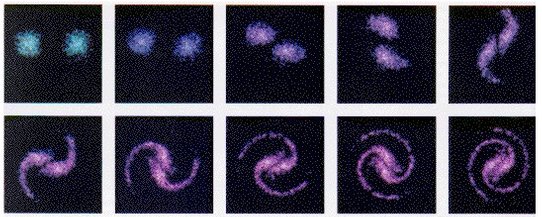Kepler-science.nl
The English pages can be found in the second row of the menu
De eerste rij knoppen in het menu is voor de Nederlandse pagina's
Universe
How far can we look into the universe? Parallax of a number of stars gets us to a distance of about 300 light years, but most stars seem to be further away. Comparing the brightness of similar stars could help us to see further (but this method has assumptions - how these be checked?). Even so most of the stars seem to be even further away..
Redshift and how to explain the phenomenon
The light stars emit can be analysed. Many stars show what is called redshift: the frequency of the light is less than it should be (towards the red in the spectrum). Some stars show blueshift (a higher frequency than expected). Redshift can be explained in a number of ways:
- Caused by the Doppler effect: most stars flee away from us. This lead to the Big Bang theory: the universe came into existence by a Big Bang, an enormous explosion resulting in matter, galaxies, stars and planets being formed over time. The theory is very popular, but still has the problem we cannot find most of the (dark) mass and the (dark) energy there should be in this model of the universe.
- Light looses energy traveling over long distances causing lower frequencies: the tired light hypothesis. This leaves open how the universe came into existence.
- Gravity can also slow down light, stretching it out, lowering the frequency.
- The speed of light has diminished over time, having reached the current constant speed only recently. This points to a relative young universe.
Two Genesis models
If God created the universe we cannot know much about the beginning because the natural laws do not apply to that beginning. Some polyphyletic scientists (see Origins) support the Big Bang because that way creation has a real start. Every model available (about 10 have been put forward) has serious problems to overcome. Maybe we just cannot know ...
Two totally different solutions have been proposed to deal with the high ages the most distant stars seem to have - and still stick to a young Earth (what the Bible seems to teach)h: the Plasma model of Setterfield and the Stretched Universe model of Humphreys (based on Einstein's relativity theories).
Setterfield's plasma model
Calculations about a possibly decreasing speed of light show it could have been infinite about 6000-10.000 years ago (consistent with the Biblical record). The speed of light also influences radiometric dating.
The model proposed by Setterfield is intruiging and should be compared to the Big Bang model. One important part of the model of Setterfield is the way it explains the formation of Galaxies and our own solar system: it can be done by plasma (the fourth, ionised state of matter). In the lab the different schapes of plasma structures can be observed (pictures above) - they look quite like the galaxy structures we see in the universe. Setterfield states that gravity cannot explain the forming and swirling of galaxies, because it's too weak as a force. And we miss 90% of the matter and energy that are necessary to let the Big Bang model work. Setterfield's model doesn't need this so called dark matter and energy. More on the Setterfield page.
If you are in a train the trees seem to move faster than the mountains further away and the Moon doesn't seem to move at all (see animation).
The same applies to stars. If the Earth orbits the Sun the closest stars seem to move to and fro a bit. In the drawing you see star A move a bit, star B a bit more and D the most - which means that D is closest to us and C, E and F are to far to see parallax. You need a good telescope to observe this: only in 1838 Bessel succeeded to observe parallax for the first time..
Links:
- Wikipedia on parallax, on cepheids and Redshift
- Wikipedia on a critic of redshift: Halton Arp
- The NASA Hubble site
- About the model of Setterfield
- About the model of Humphreys (first article in a series of three)
- About Russel Humphreys with extra links
- About: Planck data and the Big Bang
- Impact of gravitational waves on creation models
- Can christians accept the Big Bang? A podcast and links to more articles about it on creation.com.
- Articles about astronomy
- For more Dutch links go to: heelal
Humphreys' model of a stretched universe
In our experience time equals distance divided by speed. Einstein’s General Relativity theory suggests time can be distorted by gravity- some observations support that idea.
Russel Humphreys uses Einstein’s equations. He assumes the universe has a centre and that the Earth is close to this centre - which is supported by our observations and cannot be refuted by science.
Redshift bands suggest our Milky Way is grouped in concentric circles around this centre. Expansion of the universe in the past can be deduced from observations and is supported by Genesis 1:7, Isaiah 40:22+28, 42:5, 45:12, Jeremiah 10:12 and Zacharia 12:1.
If the universe has been stretched out in a short time from a limited universe, calculations using Einstein’s equations suggest gravity caused an impressive expansion of the universe. Observers on Earth would have noticed a much higher light speed and rotation of galaxies. But within these galaxies the speed of light would have seemed ‘normal’, just like their speed of rotation. From a point far into space the time on Earth would have seemed to stand still, but you wouldn’t have noticed that on Earth.
So if God stretched out space very fast, clocks on on Earth (close to the centre of the universe) would tick very slowly compared to clocks in galaxies further away in the expanding universe.
This seems a somewhat mind-boggling theory, but for theoretical physicists it's piece of cake ...
For more on this model use link nr. 6: you will find more links at the bottom of this first article.








